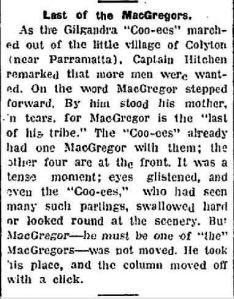The McGregor brothers at Colyton
The Farmer and Settler reported that a recruit that joined the Coo-ee March at the village of Colyton on 10th November 1915 ‘… was one of the family of McGregors that has already given five sons to the Empire. As the family said their brave but tearful farewells to the sixth McGregor, all that witnessed that incident realised the fine loyalty of the McGregors…’.[1]
The Sydney Morning Herald, and The Cumberland Argus and Fruitgrowers Advocate, both reported that at Colyton ‘Here it was that a young man stepped forward at the call for recruits. He was a member of a family – the McGregors – that had already given five sons to the Empire’s cause, and he was the sixth. A little family group bade him farewell, as with some determination he took his place in the ranks…’.[2]
The Inverell Times, and the Glen Innes Examiner, both printed the following story:
‘As the Gilgandra “Coo-ees” marched out of the little village of Colyton (near Parramatta), Captain Hitchen remarked that more men were wanted. On the word MacGregor stepped forward. By him stood his mother, in tears, for MacGregor is the “last of his tribe.” The “Coo-ees” already had one MacGregor with them; the other four at the front. It was a tense moment; eyes glistened, and even the “Coo-ees,” who had seen many such partings, swallowed hard or looked round at the scenery. But MacGregor—he must be one of “the” MacGregors—was not moved. He took his place, and the column moved off’.[3]
Andrew McGregor (1858-1910) and Alice Mary McGregor (nee Hunt) (1862-1897), who both had died before the First World War, had six sons: Andrew James McGregor (1882-1938) who joined the Coo-ees at Gilgandra; Arthur Ernest McGregor (1884-1969) who signed up to join the Coo-ees at Springwood; William George McGregor (1889-1941) who enlisted in the AIF on 2nd February 1915 (Service no. 2064); Oscar John McGregor (1891-1932) who enlisted in the AIF on 1st July 1915 (Service no. 2886); Frederick Herbert McGregor (1893- 1939)[who does not appear to have enlisted]; and , Charles Henry McGregor (1896-1916) who enlisted in the AIF on 7th May 1915 (Service no. 2657).
It is not known which McGregor brother was reported in the newspapers to have joined the Coo-ees at Colyton on their way from Penrith to Parramatta on Wednesday 10th November 1915. There was no official count for any recruits joining the Coo-ee March at Colyton.
Three of the brothers (William George McGegor, Oscar John McGregor, and Charles Henry McGregor) had already enlisted earlier in 1915, before the Coo-ee March.
It may possibly have been one of the two brothers who had already joined the Coo-ee March (Andrew James McGregor or Arthur Ernest McGregor), who may have briefly left the march to say goodbye to his family and/or finalize his affairs in Sydney (where both their next of kin lived), before rejoining the march at Colyton.
Alternatively it could possibly have been Frederick Herbert McGregor who may have stepped forward to try and join up to be with his two brothers who had already enlisted in the Coo-ee March, (and his other three brothers who had enlisted earlier in 1915), and who may then not have passed the medical examination at Parramatta that evening. Only 27 of the 41 who presented at Parramatta passed the medical examination.
However, only five of the six McGregor brothers appear to have been successful in enlisting in the AIF in the First World War.
A photograph of the five McGregor brothers who enlisted in the AIF was published in the Daily Telegraph on 22nd September 1916.[4]
The photograph had the caption: ‘(1) Private Arthur E. McGregor, Australian Army Service Corps; (2) Sergeant-Signaller William McGregor, at the front; (3) Private Oscar J. McGregor, at the front; (4) Pioneer Andrew J. McGregor, at the front; (centre), Signaller Charles McGregor, died of wounds”.
If it was Frederick Herbert McGregor who tried to join his two brothers who had already enlisted in the Coo-ee March at Colyton, there is no mention of him in an article about the Coo-ees that was published a year later in the Sunday Times, which reported that ‘Wee McGregor [Andrew James MacGregor], as he was known all along the march, sold out a flourishing bakery business in Gilgandra to join the Coo-ees. He had three brothers at the front, and he wanted to follow them. On the way to Sydney another brother jumped in the ranks – five from one family’.[5]
[1] ‘The Route March : In the Suburbs of Sydney’, The Farmer and Settler, 12 November 1915, p. 3, http://nla.gov.au/nla.news-article116652489
[2] ‘Overland. March of the Gilgandra Recruits. Welcome at Parramatta’, The Sydney Morning Herald, 11 November 1915, p. 9, http://nla.gov.au/nla.news-article15624001 ; ‘The March from Penrith’, The Cumberland Argus and Fruitgrowers Advocate, 13 November 1915, p. 11, http://nla.gov.au/nla.news-article86101787
[3] ‘Last of the MacGregors’, The Inverell Times, 19 November 1915, p. 4, http://nla.gov.au/nla.news-article185649407 ; ‘Last of the MacGregors’, . (1915, November 15). Glen Innes Examiner, 15 November 1915, p. 5, http://nla.gov.au/nla.news-article184175444
[4] ‘McGregor brothers of Glebe’, Daily Telegraph, 22 September 1916, p. 9.
[5] ‘The Coo-ees en route for Berlin : anniversary of their start’, Sunday Times, 8 October 1916, p. 9, http://nla.gov.au/nla.news-article121335018






